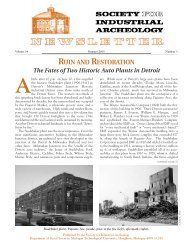birmingham, “pittsburgh of the south,” - Society for Industrial ...
birmingham, “pittsburgh of the south,” - Society for Industrial ...
birmingham, “pittsburgh of the south,” - Society for Industrial ...
You also want an ePaper? Increase the reach of your titles
YUMPU automatically turns print PDFs into web optimized ePapers that Google loves.
Robert Stewart photo<br />
BIRMINGHAM (continued from page 2)<br />
lous to learn that Japan supplies <strong>the</strong> coke used in <strong>the</strong> smelting<br />
process. Our next stop at Fairfield was <strong>the</strong> 1930s-vintage 68-inch<br />
hot strip mill, where steel slabs from <strong>the</strong> continuous caster are<br />
reheated, <strong>the</strong>n make <strong>the</strong>ir way through a series <strong>of</strong> roughing stands<br />
and finishing mills (extending <strong>the</strong> steel strip up to 5,000 feet in<br />
length) to two coil-winding stations. The finished strip, from 28inches<br />
to 50-inches wide, and from 40-gauge to one-half inch in<br />
thickness, is supplied to <strong>the</strong> construction industry. A visit to <strong>the</strong><br />
Fairfield “Dualine<strong>”</strong> zinc and aluminum coating line (<strong>for</strong> galvanized<br />
and galvalume products) ended a busy day <strong>of</strong> tours.<br />
On Thursday evening, <strong>the</strong> Sloss Furnaces National Historic<br />
Landmark, a city-operated historic site and museum, hosted a<br />
welcoming reception featuring an iron pour (using <strong>the</strong> molds<br />
crafted by foundry workshop participants earlier in <strong>the</strong> week), a<br />
light meal, and self-guided tours <strong>of</strong> <strong>the</strong> Sloss site. The present furnaces,<br />
which date from <strong>the</strong> mid-1920s, became a cause célèbre<br />
when <strong>the</strong>y were closed in 1971 and threatened with destruction.<br />
Through <strong>the</strong> ef<strong>for</strong>ts <strong>of</strong> <strong>the</strong> Sloss Furnace Assn., <strong>the</strong> property was<br />
deeded to <strong>the</strong> city <strong>of</strong> Birmingham. Today, besides serving as <strong>the</strong><br />
quintessential symbol <strong>of</strong> <strong>the</strong> city and a model <strong>for</strong> large-scale industrial<br />
site preservation, <strong>the</strong> landmark site hosts music festivals, metalworking<br />
classes, and Halloween “fright nights,<strong>”</strong> in addition to<br />
tours and lectures.<br />
Friday morning began at <strong>the</strong> 2,000-acre site <strong>of</strong> Birmingham’s<br />
American Cast Iron Pipe Co., better known as ACIPCO, where<br />
2,200 employees produce a diversified line <strong>of</strong> products including<br />
ductile-iron pipe and fittings, gate valves, tapping sleeves, and<br />
electric-resistance-welded steel pipe <strong>for</strong> <strong>the</strong> petroleum industry.<br />
We began in <strong>the</strong> latter mill. ACIPCO buys skelp (steel coil) from<br />
several suppliers, unrolls it, and shears it to specified width. A<br />
series <strong>of</strong> roll-<strong>for</strong>mers <strong>the</strong>n progressively shape <strong>the</strong> steel sheet into<br />
pipe. The pipe is welded, annealed, ultrasonically and hydrostatically<br />
tested, and coated with powdered epoxy. We next visited<br />
<strong>the</strong> machine shop and <strong>the</strong> monocast production unit, ACIPCO’s<br />
primary melt shop <strong>for</strong> ductile iron, with its impressive 108-inchdiameter<br />
cupola (soon, we were told, to be replaced). Next came<br />
<strong>the</strong> piéce de résistance: <strong>the</strong> centrifugal pipe mill, which makes water<br />
and sewer pipe. There, a ladle pours molten ductile metal into a<br />
trough, which conveys it into a spinning, cylindrical steel mold<br />
<strong>Society</strong> <strong>for</strong> <strong>Industrial</strong> Archeology Newsletter, Vol.28, No. 4, Winter 1999<br />
housed within <strong>the</strong> casting machine. The molten iron is thrown by<br />
centrifugal <strong>for</strong>ce against <strong>the</strong> outer wall <strong>of</strong> <strong>the</strong> mold, resulting,<br />
within minutes, in a seamless pipe <strong>of</strong> uni<strong>for</strong>m diameter and wall<br />
thickness. Each casting machine is manned (yes, manned) by two<br />
workers: <strong>the</strong> casting machine operator and a “trough man.<strong>”</strong> The<br />
trough man, after each pour, uses a paintbrush to coat <strong>the</strong> trough<br />
with a carbon and water mixture. The heat, noise, and drama <strong>of</strong><br />
<strong>the</strong> operation are intense, even from <strong>the</strong> catwalk on which we<br />
stood; one could hardly imagine what it must be like to work down<br />
on <strong>the</strong> mill floor. Leaving <strong>the</strong> centrifugal casting operation, some<br />
<strong>of</strong> us had to leap <strong>for</strong> cover as a “sling out“—a sudden shower <strong>of</strong> hot<br />
metal—came our way as <strong>the</strong> pouring ladle finished discharging its<br />
contents and <strong>the</strong> last <strong>of</strong> <strong>the</strong> molten iron hit <strong>the</strong> lip <strong>of</strong> <strong>the</strong> spinning<br />
mill. ACIPCO’s unusual corporate structure was evident as we<br />
walked through <strong>the</strong> plant. The company operates under <strong>the</strong><br />
Eagan Trust set up by John Joseph Eagan (1870-1924), an ACIP-<br />
CO founder and its first president. Eagan deposited all <strong>of</strong> <strong>the</strong> common<br />
stock <strong>of</strong> <strong>the</strong> company in <strong>the</strong> trust in order to demonstrate <strong>the</strong><br />
practicality <strong>of</strong> operating an industry on “Christian principles.<strong>”</strong><br />
The trust provides complete medical and dental services, a pension<br />
plan, and a pr<strong>of</strong>it-sharing plan. An employee-participation<br />
system is designed to encourage teamwork and efficiency.<br />
From ACIPCO we headed to Boral Bricks, America’s largest<br />
brick manufacturer. One <strong>of</strong> fourteen manufacturing facilities, Boral’s<br />
Bessemer plant occupies a <strong>for</strong>mer clay-pipe plant recently retr<strong>of</strong>itted<br />
to make brick. Here <strong>the</strong> Australian-owned company makes extruded<br />
face (or common) brick <strong>for</strong> a national market using varying proportions<br />
<strong>of</strong> four ingredients: blue shale, yellow shale, Centerville<br />
clay, and fire clay. Our tour began at <strong>the</strong> primary crusher, <strong>the</strong>n<br />
moved to <strong>the</strong> grinding room, where materials are stored in segregated<br />
piles. A front-end loader deposits <strong>the</strong> correct proportions <strong>of</strong> raw<br />
materials in a pug mill, water is added, and <strong>the</strong> mill cuts “slugs<strong>”</strong>—<br />
long, wet cakes <strong>of</strong> colored brick. Some <strong>of</strong> <strong>the</strong> slugs are textured with<br />
artificial distress marks to simulate old, handcrafted brick. The s<strong>of</strong>t,<br />
wet slugs are <strong>the</strong>n wire-cut, separated and stacked, placed in a holding<br />
room, and dried <strong>for</strong> 24 hours. They <strong>the</strong>n slowly pass through one<br />
<strong>of</strong> two 12-foot-wide, 2000° F. kilns. Their journey takes 33 hours.<br />
After cooling, <strong>the</strong> bricks are baled into cubes containing 520 bricks<br />
each. Following <strong>the</strong> tour, we found complimentary box lunches and<br />
insulated “Boral Bricks<strong>”</strong> mugs waiting in our seats on <strong>the</strong> bus.<br />
Fall Tour ’99 participants ga<strong>the</strong>r in front <strong>of</strong> <strong>the</strong> electrical substation at Birmingham’s Cahaba Pumping Station.<br />
(continued on page 4)<br />
3






